The Best Food and Beer of Belgium: 15 Things You Should Taste


What is the most traditional food in Belgium?
What food is Belgium famous for?
What is a typical Belgian meal?
What do Belgians eat for breakfast?
1. Belgian fries (not French fries!)
3. Belgian chocolate and pralines
6. Meatballs with tomato (or a different sauce)
Good to know: more traditional Belgian dishes
Belgian drinks and traditional beverages
Other traditional Belgian drinks
2. Jenever: Belgium’s answer to gin
3. Coffee: Belgians drink a lot of it
4. Hot chocolate: comfort in a cup
What do vegetarians eat in Belgium?
Typical Belgian meals—breakfast, lunch, and dinner
The traditional food of Belgium is a mix of French elegance, Dutch comfort, and German heartiness, and it’s impossible to leave the country hungry. You may eat too many fried though!
Belgian cuisine reflects the country's culture and regional diversity—remember that when you’re eating grey shrimps one minute and cheese croquettes the next.
I was happy to do Belgian food research during multiple trips to Belgium—I can’t deny that eating my way through a country is my favorite way to travel!
So, what do you think of when Belgian cuisine is mentioned? Probably chocolate and waffles? Fries?
All this is absolutely true and fair, but the traditional food of Belgium offers more than that—with stews, seafood, game, croquettes, and sauces so good you’ll be wishing for dinnertime to come faster.
What I admire most about Belgian food if how it always seems prepared to perfection. It’s not “just fries”—if anything, it’s “the perfect combination of crunchiness and softness in a double-fried potato masterpiece”. It’s why they have so many Michelin restaurants.
In this article, I’ll tell you some Belgian food facts, what the best traditional food of Belgium is, talk about the French influence in Belgian cuisine, dive into traditional Christmas foods, and even teach you about the main types of Belgian beer and Belgian waffles. Who’s hungry??
Read more from my Belgium travel blog.

Bruges showing off its storybook charm—because yes, it really does look like this in real life
You might also be interested in reading:
- Belgium Itinerary: 7 Days in the Heart of Europe!
- Belgium Travel Tips: 19 Things That Will Make Your Trip Easier
- Is Bruges worth visiting?
- Ranking 9 Top Restaurants in Belgium
- 7 Best Day Trips from Brussels (Includes Train Details)
Belgian food culture—what Belgians actually eat and how they eat it
Belgians love food. The Belgian food culture is about balance—fine ingredients, bold flavors, and no rush. Belgians eat well and take it seriously. I can respect that.
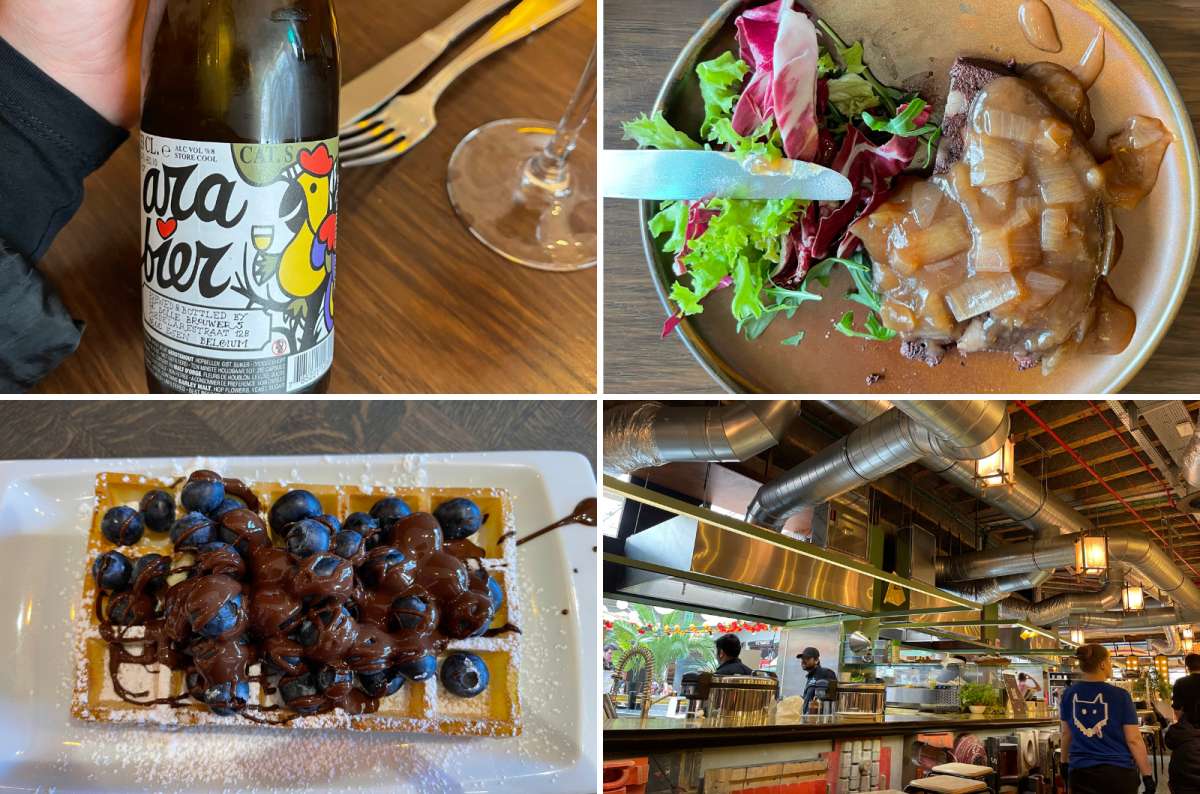
Belgian food culture in a nutshell—slow meals, rich sauces, and a lot of love (and beer) in every bite
I’ve found that:
-
Meals are slow and social. Belgians sit, eat, and talk. You don’t walk and eat in Belgium (except fries).
-
Beer replaces wine. Most traditional Belgian dishes use beer in cooking—especially in stews and sauces. And instead of a wine pairing, you get the perfect glass of beer in a restaurant.
-
Quality matters. Even simple food like fries or meatballs is done properly. See my section below about how many Michelin restaurants Belgium has which proves this.
-
Local pride is real. Flemish, Walloon, and Brussels cuisines all claim they’re the best—it causes some tension, but they’re all right in their own way I guess.
Belgians often have a favorite meal that reflects their regional identity, such as waterzooi from Ghent, a creamy chicken or fish stew with vegetables and eggs, or stoofvlees from Flanders, a rich beef stew slow-cooked in dark beer until it melts in your mouth. You’ll notice that these meals can be a point of pride because they’re tied to local traditions.
The typical Belgian food lineup: meat or fish, potatoes (often fried), some vegetables, and sauce—always sauce. The cuisine of Belgium is comfort food with finesse: slow-cooked beef in beer, mussels with fries, shrimp croquettes, and desserts that don't skimp on sugar and butter.

Belgium may borrow from French finesse, but like Parc du Cinquantenaire itself, it turns tradition into something uniquely its own
Influence of French cuisine in Belgian traditional food
It’s impossible to talk about traditional Belgian cuisine without mentioning French cuisine. The two countries share a border and a love for good food. The French influence is most obvious in Wallonia, the southern region of Belgium which is closest to France.
I like to think of it as French inspiration and Belgian innovation. Many classic Belgian dishes, like carbonade flamande(a hearty beef stew simmered in Belgian beer) and steak tartare (finely chopped raw beef seasoned to perfection), come from French culinary traditions.
The French love of sauces and marinades has very clearly found a happy home in Belgian kitchens. Everything from meatballs to seafood is elevated.
But there are also things like Belgian waffles where Belgium has put its own spin on a French classic, no matter if you’re trying a Brussels waffle topped with whipped cream or a Liège waffle studded with pearl sugar.
Sometimes, all you need to do is take the first step... I've filtered out the best hotels in Brussels for you
Save it for yourself to come back to later, or share with your friends on social media!
I've already planned your ititnerary for the trip, complete with my travel tips.
Regional differences in Belgian cuisine
The cuisine of Belgium changes completely depending on where you are. In the same way that the country is split linguistically, it’s also divided by food preferences—and the divide runs deep.
I consider myself a foodie and I’m quick to judge and quicker to enjoy. Belgian food, with all its regional influences, had me curious from my very first trip to Belgium.
- Flemish cuisine (in the north) is heavily influenced by Dutch cooking. Expect comfort food: a lot of fried dishes, stews cooked in beer, croquettes, fries, and seafood like shrimp and mussels. It’s hearty, brown, and filling—not great for your diet but excellent for your mood.
- Walloon cuisine (in the south) leans toward French-style cooking. It’s full of creamy sauces, pâtés, and rich dishes with game or poultry. The presentation is prettier, the flavors more refined, and there’s usually more butter involved.
- Brussels cuisine sits right in the middle. It borrows from both sides—you’ll find French finesse in restaurants, Flemish heartiness in brasseries, and international food everywhere in between. It’s where traditional Belgian dishes like moules-frites (a popular dish in Brussels), stoofvlees (another popular dish), and Belgian wafflesall coexist happily.
The regional diversity in Belgian food is what makes it special. Each area does its own thing, and none of them are wrong. Whether you prefer a beer-based stew in Ghent or a creamy rabbit dish in Namur, you’ll end up satisfied—and possibly addicted to the cuisine of Belgium.

Fun facts and food tips about Belgium

Forget restraint—Belgium took a French dessert idea and made it a full-blown masterpiece
A few things I learned while eating my way through Belgium:
- If you don’t know which beer to order, ask for a degustation. Most bars will bring you small glasses so you can taste a few and pick your favorite. It’s normal, not snobby.
- Fries were invented in Belgium, not France. Americans just misheard French-speaking Belgians during World War I, when American soldiers encountered fries prepared by Belgian soldiers and mistakenly called them French fries. The Belgians still haven’t forgiven them.
- Avoid beef tartare if you’re pregnant or have a weak stomach. It’s raw beef, not steak. But if you’re not pregnant, have it at least once!
- Pâté and Belgian chocolate make great souvenirs. It’s just hard not to eat them before you see the person they’re meant for.
- Belgians eat fries with everything. Meatballs? Fries. Stew? Fries. Mussels? Fries. If there were a national side dish, Belgian fries would have no competition.
- Belgium’s Ghent region started “Veggie Thursdays.” Super weird that this is a Belgian idea—just wait until you see all the meat!
- Beer and chocolate pair better than wine and chocolate. Try it.
- Fries are fried twice. Once to cook them, once to make them perfect. That second fry is where the magic happens.
- Belgians love sauce. You’ll get sauce with everything. And then another sauce. And sometimes a backup sauce..

My favorite traditional food in Belgium: 12 memorable dishes

Belgian food making us smile @ Nüetnigenoug in Brussels
1. Belgian fries (not French fries!)
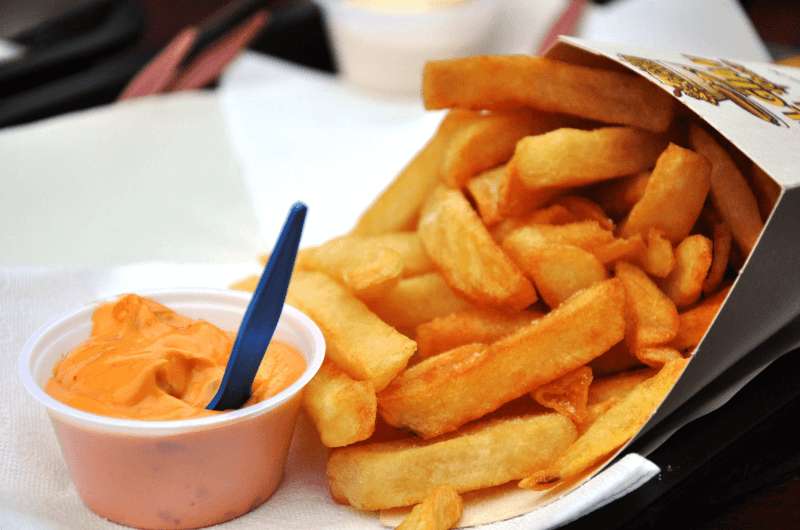
Can’t choose between may and ketchup? Andalouse sauce is kind of like a combination of the two
I’m just going to say it—Belgian fries are the best fries I’ve ever had. They’re thick and double-fried, resulting in a heavenly crispy exterior and a soft inside. The first frying is meant to cook them, the second, done right before serving, is to add color and crunch.
Belgians call them frites (in French) or frieten (in Flemish), and they take this traditional Belgian food very seriously. I learned quickly that calling them French fries may cause some irritation—oops.
They come with everything—seriously, fries are the backbone of Belgian cuisine. A cultural quirk of Belgians is that they prefer to dip it in mayonnaise rather than ketchup. Andalouse sauce, a mix of mayonnaise, tomato paste, and peppers, is another favorite.
You’ll find fry shops, often called fry shacks or frietkots, on every corner in Belgium. Fried are traditionally served in a cornet de frites—a cone-shaped paper container that is part of the authentic Belgian street food experience.

The history of fries
So why are they called French fries? Some sources say it is because of a mistake. During WWI, American soldiers stationed in Belgium recognized the French language being spoken all around them and assumed they must be in France. When they tasted and fell in love with the now-world-famous fried potato treat, they named it French fries. Oops.
Travel tip with a side of fries: If you head down south to Wallonia, you can try eating fries while listening to people speak French around you and understand the innocent soldiers’ mistake. Check out our article about the most beautiful places to visit in Belgium. Meuse Valley, along with cute Dinant town, could be the area where fries originated... if you believe the stories!
2. Beef or steak tartare
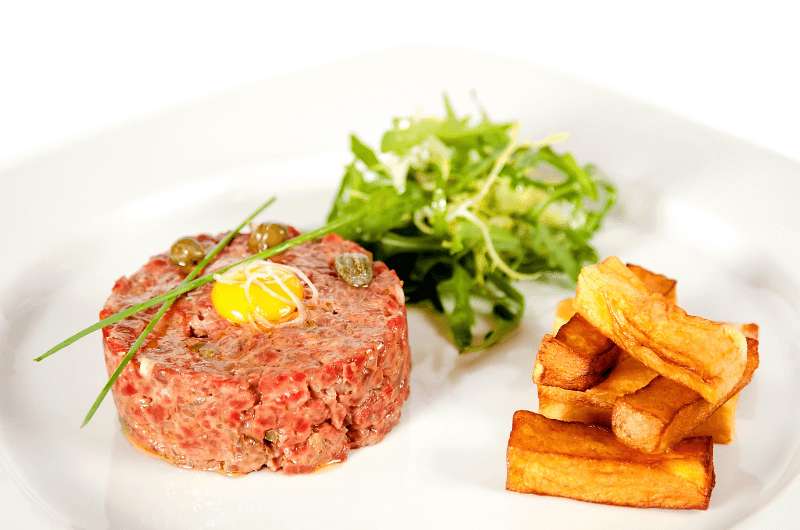
Fries come with every food in Belgium
I didn’t know what to expect when I ordered beef tartare, or filet américain, for the first time. Spoiler: it’s not steak. It’s raw, finely chopped beef seasoned with shallots, egg yolk, mustard, and capers, served cold—and yes, it’s surprisingly good.
Beef tartare is served as a round mound of finely chopped raw beef with the spices already mixed in. A common side to beef tartare are Belgian fries and, of course, an always-necessary beer.
If you order toast cannibale, you’ll get it on bread.
It’s not for everyone, but I like trying authentic Belgian dishes, and this one definitely counts.
Further reading: See my favorite Belgian restaurants, an article in which I talk about my top picks in Brussels, Ghent, and Bruges.

Proof that Belgian food is comfort with class—simple ingredients, rich flavors, and always a killer sauce
3. Belgian chocolate and pralines
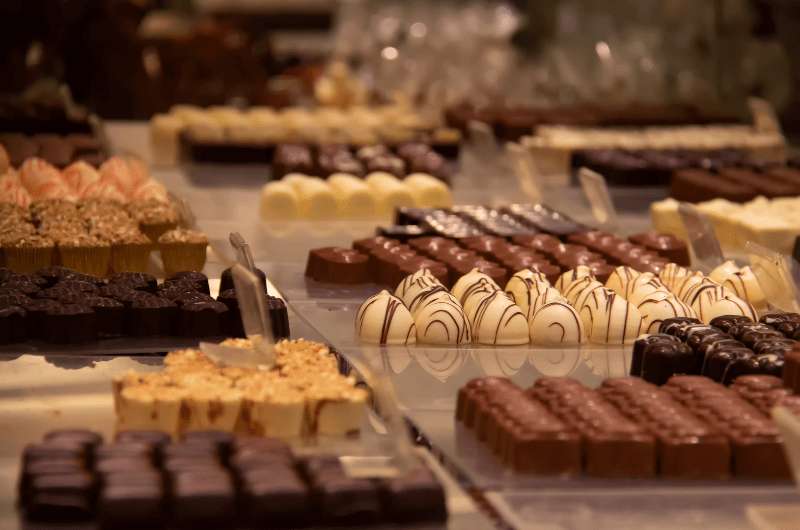
Pralines come in all shapes and not many sizes, but they’re all supposed to contain nuts of some sort
Chocolate has been a major industry in Belgium since the 19th century, and has had some association with it some 200 years before that, when Belgium was occupied by Spain, who brought it over from South America.
I’ve had chocolate in plenty of countries, but Belgian chocolate really does deserve its reputation. It’s been a national obsession since the 19th century and one of the most iconic Belgian specialties today.
The praline, invented in Brussels in 1912, is Belgium’s biggest gift to the chocolate world. The funny thing is that even though Belgian chocolate is world-renowned, there is no actual standard for what can and can’t be called Belgian chocolate aside from the fact that it has to be produced in Belgium.
Fun fact: Pralines are small chocolate confections that, according to the definition, must contain at least nuts, though a cream filling is also very common.

If you want to visit a chocolate museum in Brussels, make it Choco Story—it’s informative, fun, and yes, there are plenty of samples
There are more than 2,000 chocolate producers in Belgium. I liked the big brands like Godiva and Leonidas, but the smaller boutique shops were even better. The Belgians eat chocolate like it’s a food group—and honestly, I respect that.
4. Moules frites (mussels)

I hate 50% of the things on this plate
I’ll be honest: I hate mussels. But since moules-frites—often considered the unofficial national dish, celebrated for its popularity and traditional preparation—is the national dish of Belgium, I felt obligated to try them—or at least let my travel partner do it for me.
Belgians eat an insane amount of mussels every year, about 30 million tons. Clearly, they know something I don’t.
Mussels with fries are traditionally cooked in white wine with shallots, parsley, and butter, though there are versions with beer, cream, or curry. Mussel season in Belgium runs from July to April, and locals swear that’s when they’re best.
Even though I’m not a fan, I have to admit this dish perfectly represents Belgian cuisine: simple ingredients, cooked right, and always served with fries.

Mussels might not be everyone’s favorite, but in Belgium, they’re practically sacred. Simple, flavorful, and undeniably local
5. Belgian waffles

You can’t go wrong with strawberries!
I thought I knew waffles—then I went to Belgium. You can’t talk about traditional Belgian food without mentioning waffles, and they’re sold absolutely everywhere. That said, most of the touristy ones are garbage. I learned that the hard way.
The good ones? Otto Waffle Atelier in Bruges, Bridge in Ghent, and Maison Dandoy in Brussels. Those were unreal.
There are two main types:
-
Liège waffles – sweet, chewy, and caramelized, no toppings. The dough is made with pearl sugar, which melts and creates the signature sweetness and caramelized texture.
-
Brussels waffles – rectangular, light, and topped with fruit, whipped cream, or chocolate. They taste like heaven.
Both are perfect examples of how Belgian cuisine makes simple food taste divine.
6. Meatballs with tomato (or a different sauce)
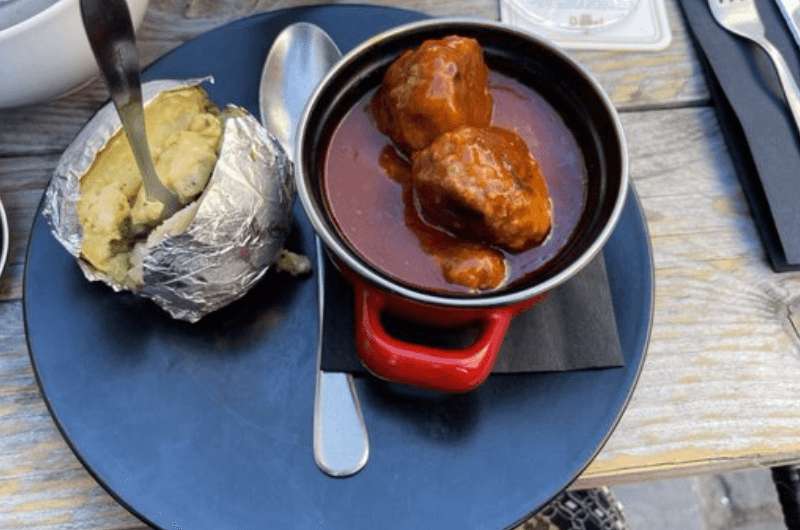
My two meatballs came with a baked potato, but trust me, you can get them with fries, too
Belgians really like their meatballs (boulets), though what you’ll typically get them served with depends on which part of the country you're in. They are usually made of half pork and half beef.
In Flanders (northern Belgium), the traditional Belgian version comes in tomato sauce, with fries on the side. And a beer.
Alternatively, they come fried in butter and served with a cherry sauce or a rich sauce inspired by French seasoning techniques. Decidedly lovely. We vote for the tomato sauce and beer.
In Wallonia (southern Belgium), they are usually served with a sweet and sour sauce, which adds a jam-like sweetness to the dish. This sauce, combining liège syrup and sometimes balsamic vinegar, is a key element of the regional specialty Boulets à la Liégeoise. They frown upon the tomato sauce variant. I frown upon them.
A grandma’s tip is that the second day after cooking the meatballs, they are even more flavorful and filling. This is the kind of Belgian comfort food that Belgian moms make for their children.
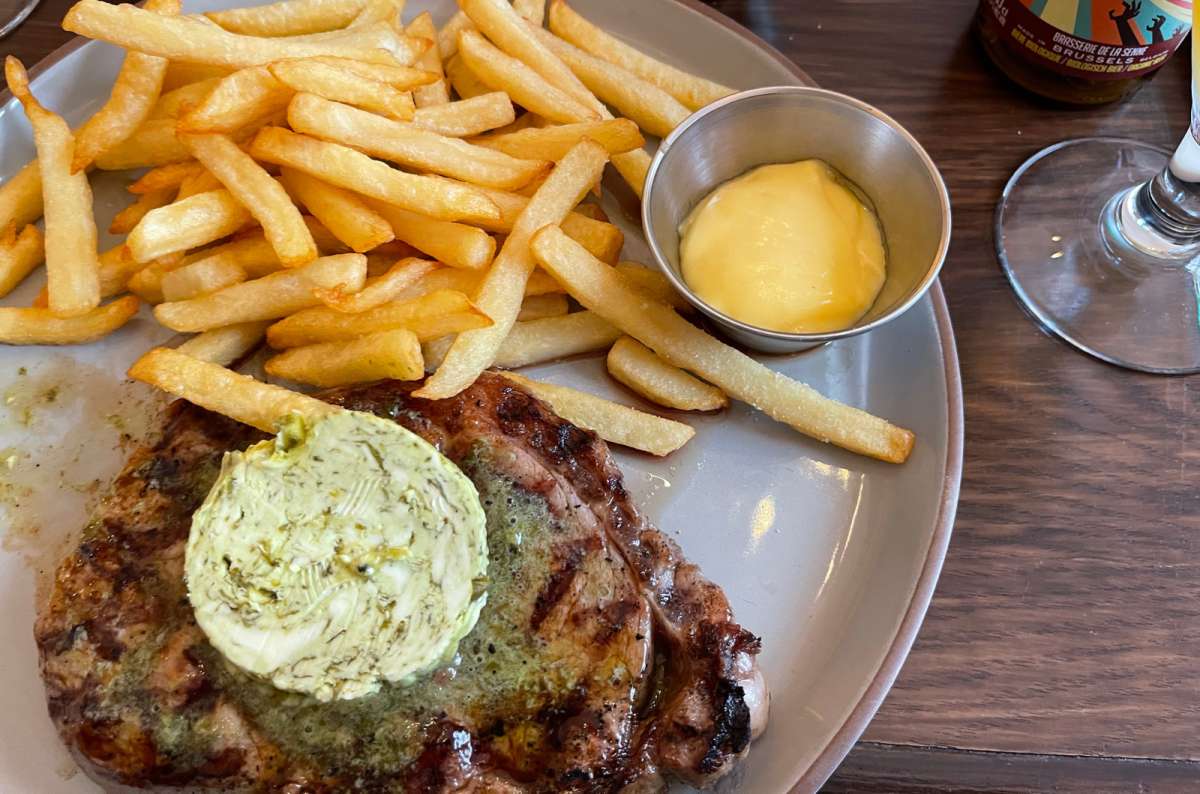
If meatballs aren’t your thing (your loss!), go for a classic Belgian steak with fries instead—it never disappoints
7. Flemish beef stew
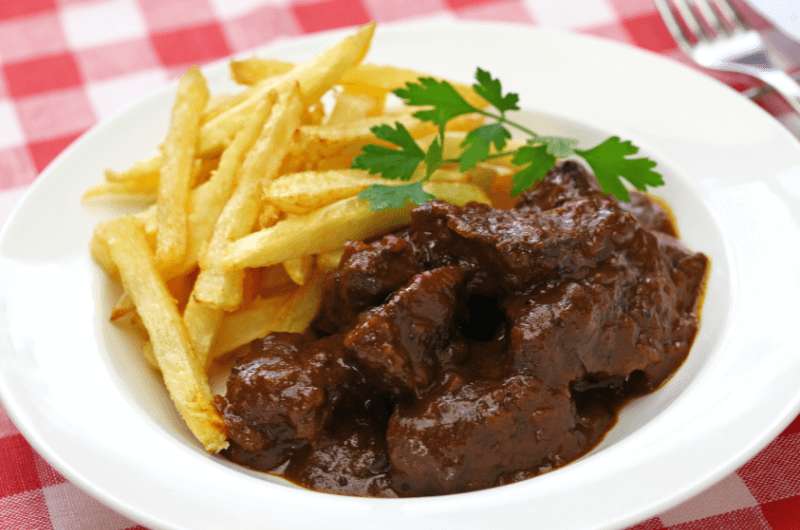
I’m not mad at it... it’s just not my favorite. But I have very high standards.
I’m Czech, so I’ve had my fair share of stews. I’ll be honest—Belgian beef stew (also known as
Flemish beef stew) didn’t make me fall head over heels, but it’s still one of the most traditional Belgian dishes you can try.
It’s beef slow-cooked with onions, mustard, and herbs—and, because this is Belgium, a special ingredient. Usually, wine is used to produce beef stews or beef bourguignon; however, Belgians typically combine the wine with… can you guess it... BEER? Correct answer!
The sauce is thick, rich, and sweet, especially if they use brown sugar or bread spread with mustard.
You’ll always get fries with it (obviously) and, as is standard in Belgium, you have to pair your stew with the right type of beer to really bring out the taste. Your server will be happy to help you with your choice.
Even though I still prefer goulash, I respect this Belgian specialty for being unapologetically hearty.
8. Croquettes

If these are cheesy, I’m sold
Belgian croquettes—or kroketten—are a very well-liked starter dish, but you can also eat them as a main meal, combined with fries and maybe a small salad.
They’re crunchy on the outside, soft inside, and filled with either cheese, mashed potatoes, or shrimp. (I’m team cheese, always.) A classic creamy component in many croquettes, especially shrimp croquettes, is béchamel sauce, which makes the texture rich and smooth.
Historically, croquettes were made out of just mashed potatoes, but nowadays, there are so many varieties that there are restaurants that serve just the fried goodness and nothing else. Except for beer. There’s always beer. No need to panic.
I tried a few versions, and every single one was dangerously good. This is Belgian comfort food at its best.
9. Shrimp-stuffed tomatoes
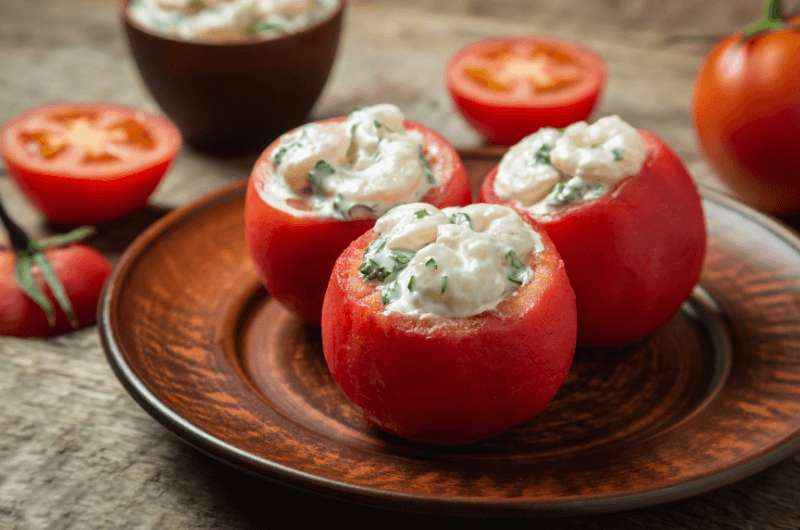
These guys are missing their “hats” made out of the piece that was cut off
Tomate crevette might be one of the simplest Belgian dishes, but it’s also one of the best.
It’s literally a tomato stuffed with small brown shrimp—the “caviar of the North Sea”—mixed with mayo and lemon juice. When the ingredients are fresh (and they have to be), it’s perfect.
I didn’t envy the person peeling those tiny shrimps, but the result was amazing: fresh, juicy, and perfectly balanced. Another reminder that Belgian cuisine isn’t just about fried food.
10. Asparagus aka white gold
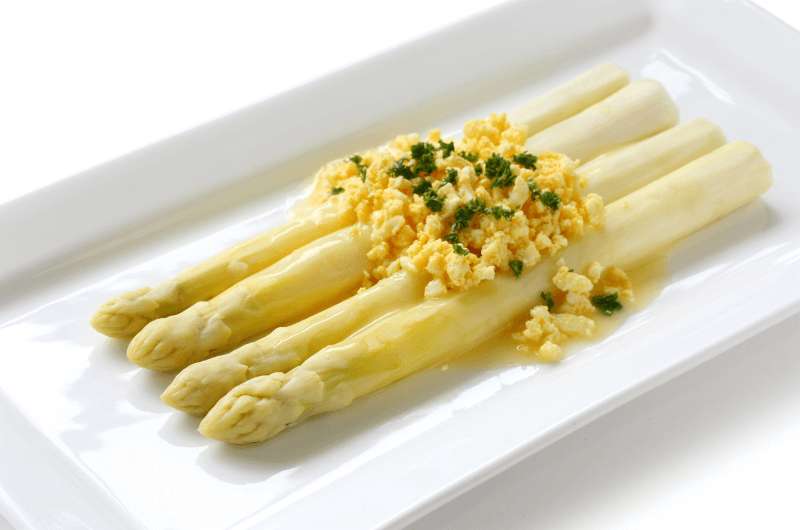
Get your serving of white gold between April and June
When I say Belgians are obsessed with asparagus, I mean it. During asparagus season (April–June), it’s on every single menu.
The traditional Flemish asparagus (Asparagus à la flamande) is a starter consisting of sticks of white asparagus with chopped or mashed hard-boiled eggs on top with a bit of parsley for color.
I was lucky to visit during the short asparagus season and finally understood why they call it white gold. It’s grown underground to stay white, making it more tender and sweeter than green asparagus.
It’s one of those seasonal Belgian specialties that actually lives up to the hype.

11. Pâtés

Eat your paté on toasted bread or crackers
Belgian pâté is perhaps the most "homemade" of all national dishes, recipes for which have been passed down from generation to generation. It’s usually made from pork liver with spices or fruit, and the beer pâté I tried was next-level good. This is one of those traditional Belgian foods that tastes like home… even if you’re not from Belgium.
They taste just as good as French pâtés, in my humble opinion. You have to try beer paté. I know I’m lame with all the beer love in this article, but this paté was top notch!
Also, they don’t add any sugar, because it would change the original taste of the product. Packaging is often hand-decorated, which is cute and the reason why I think a little paté could make a great souvenir to bring home.
Most Belgian pâté producers are family-run businesses that use only fresh meat and traditional recipes. I loved how personal it felt—and I actually brought a few back home.
If you want a local souvenir that isn’t chocolate or beer, this is it.
12. Crème brûlée

Can I get some fries and a beer with that?
Crème brûlée is a popular dessert consisting of a rich custard base topped with a layer of caramelized sugar.
But—and this is key—the Belgians often pair it with chocolate. Who could resist?! It’s indulgent and ridiculously good.Belgian sweet dishes are often inspired by French pastries, with some local twists here and there focusing on indulgent flavors.
The Belgians might share credit for it with France and Spain, but they still make it their own. I’m not usually a huge dessert person, but this one got me.
It’s not uniquely Belgian, but it’s too delicious not to include in a Belgian food guide—and a perfect way to end a meal (and a list of my favorite popular Belgian food!).

Good to know: more traditional Belgian dishes
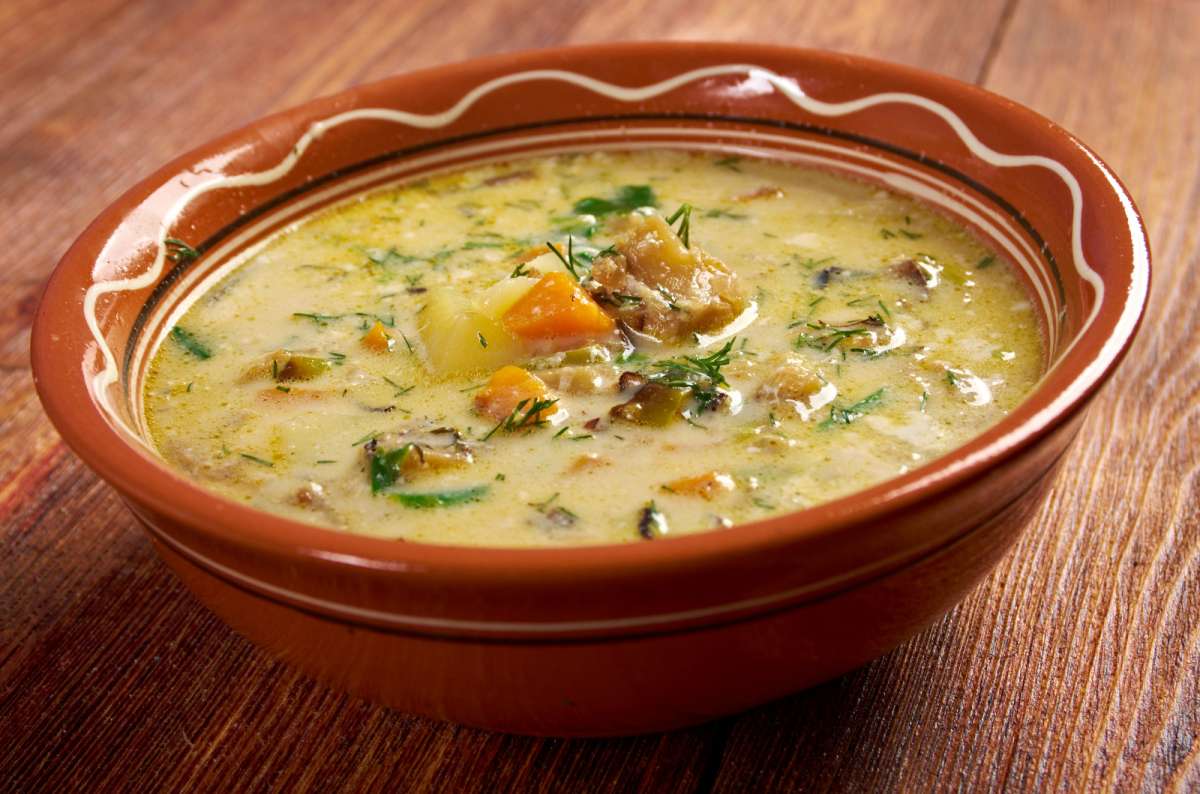
Waterzooi is Belgium’s cozy classic—rich, creamy, and proof that Belgians know how to turn simple ingredients into something unforgettable
These didn’t make my main list, but they’re all classic Belgian foods you’ll see on local menus:
- Vol-au-vent – Creamy chicken and mushroom sauce served in puff pastry. You’ll find it in every brasserie. It’s warm, filling, and comes with fries (obviously).
- Waterzooi – A delicious soup with a creamy texture and fresh herbs, originally from Ghent, made with fish or chicken, vegetables, and cream. Softer and lighter than Flemish beef stew, and honestly, I liked it more.
- Rabbit with prunes – A typical Walloon dish, sweet and savory at once. If you’re not weirded out by eating rabbit, this is worth trying.
- Stoemp – Belgian mashed potatoes with veggies (carrots, leeks, spinach—whatever’s around). It’s the definition of comfort food and usually comes with sausage or meatballs.
- Grey shrimp croquettes – You’ll see these on every seafood menu. They’re filled with North Sea shrimp and creamy béchamel, fried to golden perfection. A must-try Belgian specialty.
- Chicons au gratin – Endive is the key ingredient, enveloped in a creamy sauce and baked with ham and cheese. A staple in traditional Belgian recipes.
- Smoutebollen (deep fried balls) – Traditional deep fried balls of dough, also known as 'Lard Balls,' (appetizing, right?) are a popular sweet snack at fairs and markets throughout Belgium.
- Tarte au riz – A sweet rice tart that’s surprisingly addictive. Every Belgian bakery sells it, and they should.
- Speculoos – Spiced caramelized cookies that taste like Christmas and childhood at the same time. Belgians eat them with coffee or smear the cookie butter version (speculoos spread) on bread for breakfast.

Speculoos—yes, those little cookies that look suspiciously like Lotus biscuits, only these are really Belgian
Side dishes in Belgian cuisine
In Belgium, side dishes are super important. They make each main meal that much more delicious, comfortable, and delicious.
Stoemp, the country’s beloved mashed potatoes mixed with vegetables like carrots, leeks, or Brussels sprouts, is a staple next to sausages or meatballs.
And of course, Belgian fries need no introduction. They can be eaten with moules-frites, steak, or eaten solo with a mountain of mayo.
Other traditional Belgian sides include green beans, boiled potatoes, and crisp salads dressed in béchamel or tangy vinaigrette. Some dishes even get a drizzle of Liège syrup—a thick, fruity syrup that adds a sweet twist.

Belgian drinks and traditional beverages

You’ll be spoiled for choice when it comes to beer in Belgium. A degustation can help you figure out what you like.
Beer is not a food, but come on, this is Belgium we’re talking about! It’s part of everyday life and easily one of the most important parts of Belgian cuisine.
I’m a big beer connoisseur. As a Czech, I have every right to be skeptical of beers from other countries. But Belgian beer completely won me over. It’s spectacular. Complex, creative, and brewed with a kind of care that borders on obsession.You’ll be spoiled for choice in Belgium. The country produces over 1,500 different types of beer, from pale wheat beers to sour lambics and dark stouts.
Don’t miss trying jenever, Belgium’s national spirit. This traditional drink holds a special place in Belgian culture and is often enjoyed during festive occasions, especially at Christmas. Jenever is typically served in shot glasses to highlight its unique flavors and cultural significance.
Here are my two Belgian beer tips:
- If you’re not sure what to order, ask for a beer degustation—most bars will bring you a tasting board with smaller glasses so you can find your favorite.
- Many restaurants have beer sommeliers that will help you pair your meal with a beer!
Pro tip: Visit the Bruges Beer Experience in Bruges, one of the most interesting museums in Belgium. It gave me a whole new appreciation for Belgian brewing traditions.

Belgium takes its beer seriously—this museum proves it. If you love a good brew, don’t skip the Belgian Brewers Museum in Brussels
1. The best Belgian beer
Wheat beer—the hazy one
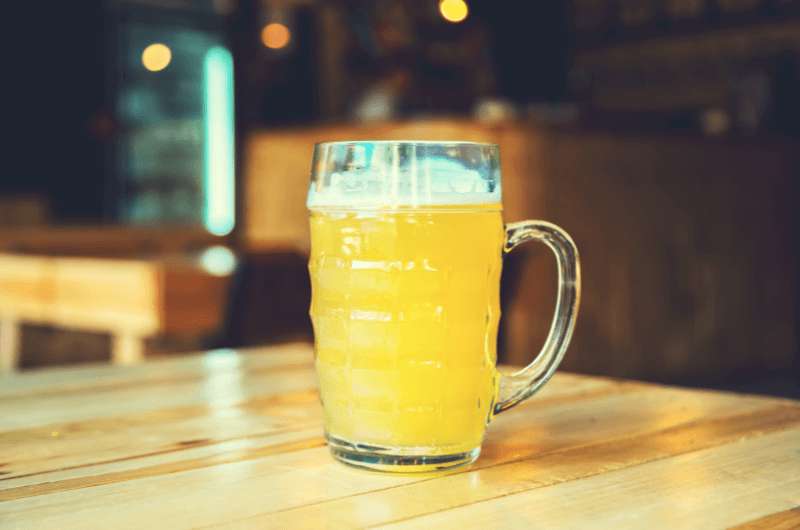
One witbier, sir
Witbier, or white beer, is made with raw (unmalted) wheat, giving it that signature hazy look. Some brewers add oats, orange peel, and coriander for flavor.
Wheat beer has a mild sour taste, which might be why the spices started to get added in the first place. It’s light, refreshing, and slightly citrusy—perfect if you don’t like the bitterness of beer.
The popular Hoegaarden has been around since the 16th century. Peter Celis, who revived the Hoegaarden brand in Belgium in the 1960s, then moved to Texas in the USA to start Celis Brewery. He’s the one who started adding those spices—and now it’s one of the most famous Belgian beers worldwide.
Lambic beer—the wild one
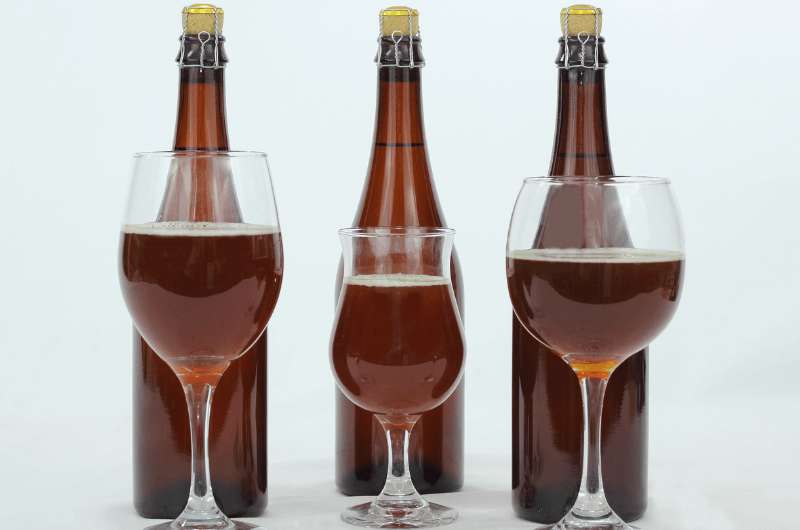
Copper-colored beer=lambic
Another beer, another color. Lambic is one of the oldest traditional Belgian beers, brewed in the Pajottenland region southwest of Brussels since the 13th century.. In places like the US, however, it’s a very new type of beer. You might even call it trendy.
Lambic is a unique flat beer that is fermented naturally—with wild yeasts and bacteria from the Senne Valley instead of strains of brewer's yeast that have been grown in a lab. If you like your beer to taste like a barnyard crossed with dirt from the cellar floor with a hint of fruitiness, lambic is for you.
Several kinds of lambic beer exist. My favorite was gueuze (blend of young and old lambics), but some people don’t like its hoppy taste. If you’re one of them, try kriek (fermented with cherries) or framboise (fermented with raspberry).
Stout beer—the naughty one
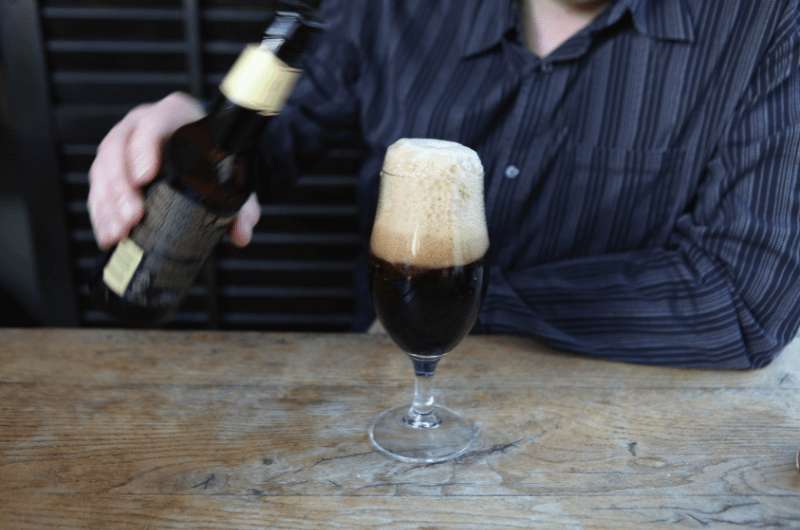
Tip: Pair your stout with some chocolate cake!
Stout is the dark, mysterious one—and the name fits perfectly. (“Stout” in Flemish literally means naughty.)
Stout has so many variations, not even beer pros can always agree on whether something is or isn’t a stout. In beer competitions, there is never a category for stout. Sometimes, any dark beer is mistakenly called a stout.
Historically, the term stout was used for any beer that had a high alcohol percentage. Today, we’re content with the conclusion that stout has to be made with unmalted roasted barley and is always dark. But it can be sweeter or smoother or dryer depending on other ingredients and their amounts added.
Stout will usually taste chocolate-y or coffee-y. I loved pairing it with chocolate desserts, especially after discovering how well Belgian beer and Belgian chocolate go together.
If you want to go deeper into Belgium’s beer culture, take a tour at De Halve Maan Brewery in Bruges. The rooftop views alone are worth it—and you can only get their unfiltered beer, Brugse Zot, right at the brewery.

Other traditional Belgian drinks
Despite appearances, there’s more to drink in Belgium than just beer.
2. Jenever: Belgium’s answer to gin
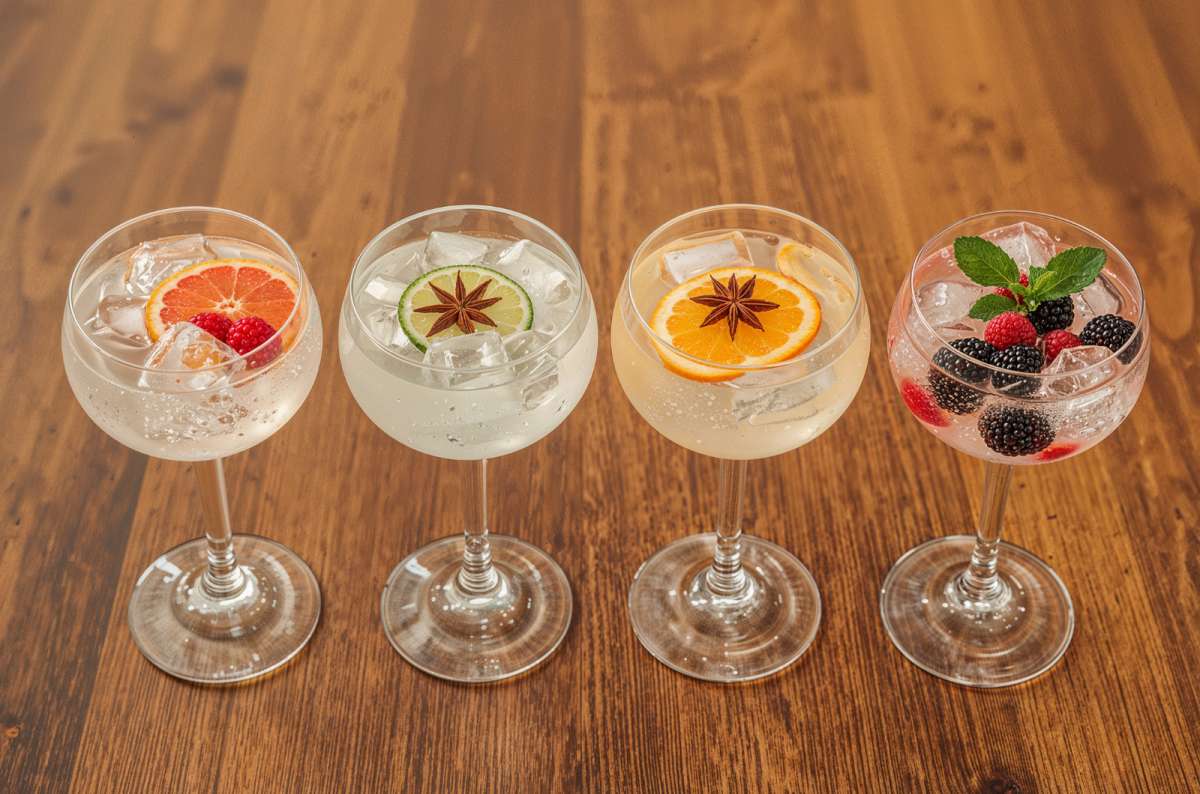
Jenever—the Belgian gin that proves beer isn’t the only way locals get happily tipsy
I tried jenever out of curiosity and ended up loving it. It’s a juniper-based spirit that existed before gin and is still popular, especially in Flanders. You’ll find it in old-school bars served cold in a small tulip glass. It’s smooth, a little spicy, and goes down very easily.
3. Coffee: Belgians drink a lot of it
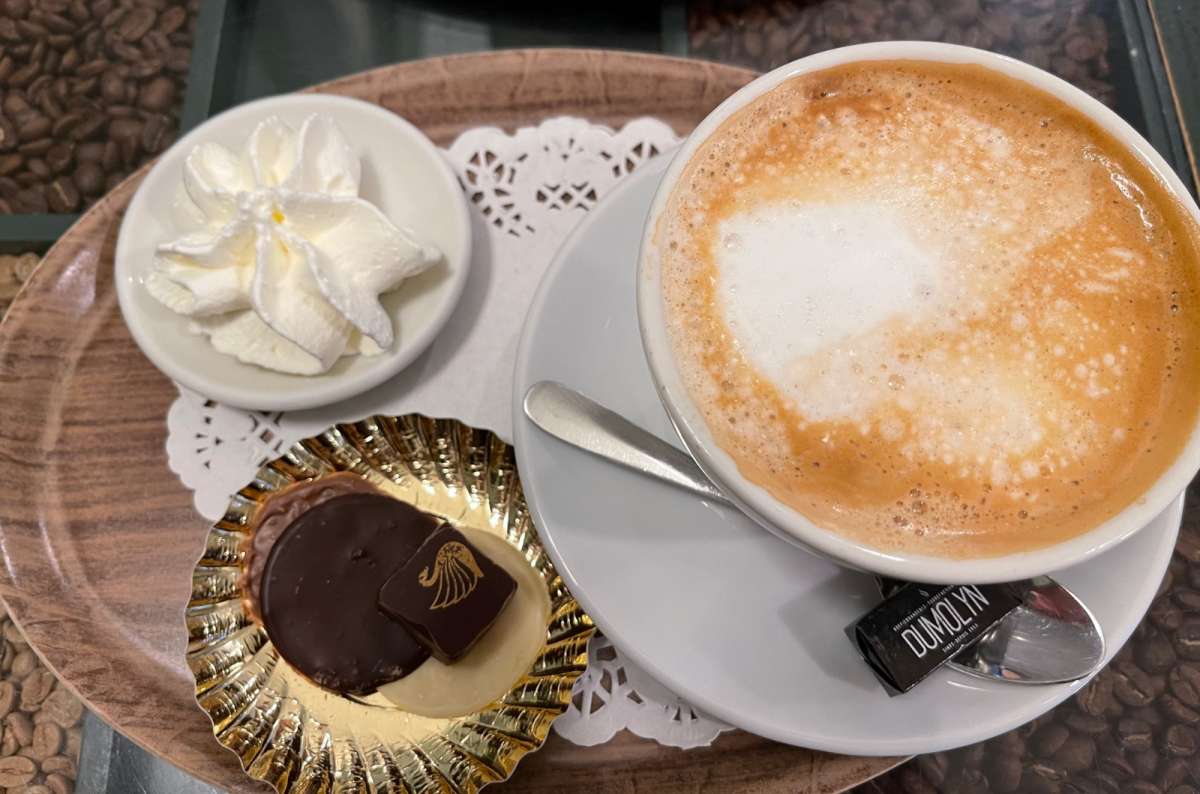
Coffee in Belgium always tastes better with a side of chocolate (and, in this case, whipped cream)
Coffee culture in Belgium is serious—espresso, cappuccino, café crème, they’re all popular. You can get good coffee almost anywhere, which is a relief after traveling through countries where that’s not guaranteed. Your coffee in Belgium will usually come with a little piece of chocolate or a cookie on the side.
4. Hot chocolate: comfort in a cup
If you love chocolate (and who doesn’t when you’re in Belgium?), don’t skip Belgian hot chocolate. The best ones are made from real melted chocolate, not powder, and you can really taste the difference. It’s thick, rich, and sometimes served with whipped cream—I don’t recommend getting one of these right before lunch or you’ll be full for another three hours and have to skip the Belgian fries.
Pro tip: If you’re visiting Belgium in winter, a Belgian hot chocolate by the Christmas markets is heaven.
Belgium’s Michelin-level food obsession

Belgium may be small, but it serves up big culinary standards—this meal wasn’t Michelin-starred, but it sure tasted like it!
Belgium, a relatively tiny country, has a whopping 143 Michelin-starred restaurants (in 2025) which—let me whip out my calculator real quick—works out to about 12 Michelin restaurants per million people. That’s wild if you compare to other food-famous countries:
- France has 654 starred restaurants—impressive, but that’s only about 9.5 per million French people.
- Italy falls short at around 6.7 per million Italians. That’s nothing compared to Belgium!
Round of applause for Belgium, everyone. Small country, big appetite for perfection.
Typical Belgian meals—breakfast, lunch, and dinner
Belgium runs on coffee, carbs, and fries. Here’s what the typical Belgian meal routine looks like:
- Breakfast in Belgium is simple and fast. Think croissants, bread with butter and jam or slices of cheese. Some people go for chocolate spread or speculoos (a cookie butter). Coffee is mandatory—and usually strong.
- Lunch in Belgium is practical. Most Belgians grab a sandwich (“smoske”), salad, or a quick quiche.
- Dinner in Belgium is where the real food comes in. This is the main meal of the day—usually meat or fish with potatoes and vegetables. Mashed potatoes are a common side dish, often served with sausages or regional specialties. Common dishes include Flemish beef stew, meatballs in tomato sauce, or mussels with fries. Belgians eat dinner around 7–8 pm and take their time.
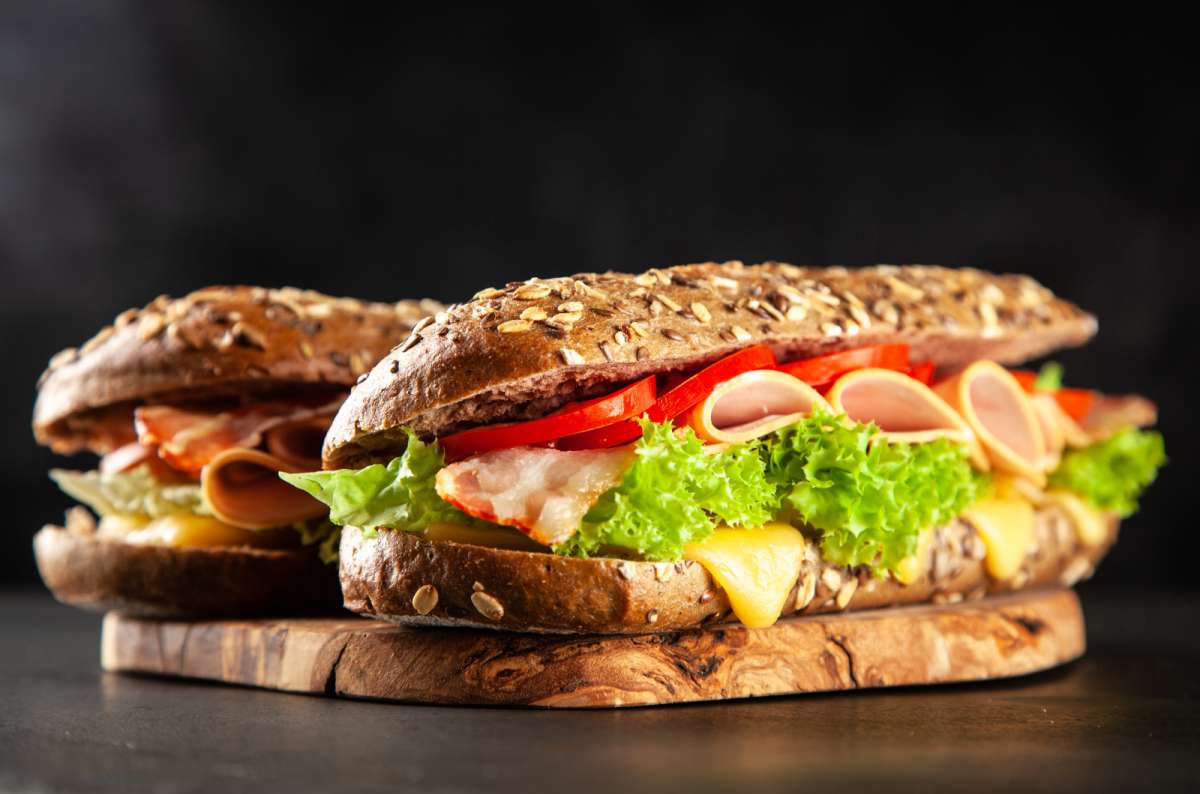
The ultimate Belgian grab-and-go—smoske sandwich packed with fresh layers of goodness
Christmas food in Belgium & other seasonal Belgian cuisine
I love how Belgians make food the main event for every holiday. Just excellent food, eaten slowly, preferably with beer or wine, and preferably twice as much as necessary.
What do Belgians eat during Christmas?
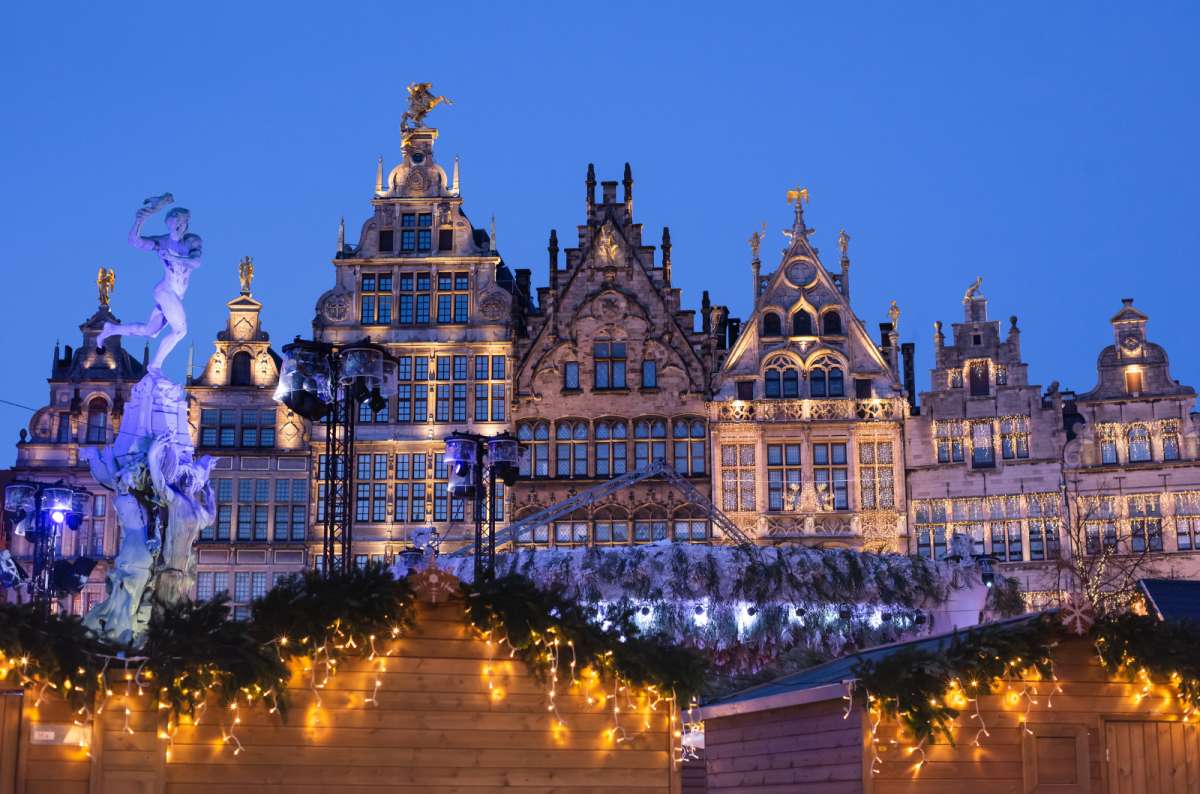
Winter magic in Antwerp’s Grote Markt—where golden statues, glowing façades, and fairy lights set the festive mood
Christmas in Belgium is basically an excuse to combine French-style elegance with Flemish-level indulgence—and then drown it all in sauce. No fries though.
Christmas food in Belgium usually means:
-
Turkey or game meat, with creamy sauces.
-
Seafood platters, especially with shrimp and oysters.
-
Stuffed turkey or rabbit with prunes are common mains.
-
Croquettes make yet another appearance (can’t see anybody complaining about that).
-
Dishes featuring Liège syrup, which is made from evaporated fruit juices such as apples and pears, sometimes appear in festive recipes, adding a sweet and tangy note to holiday dishes.
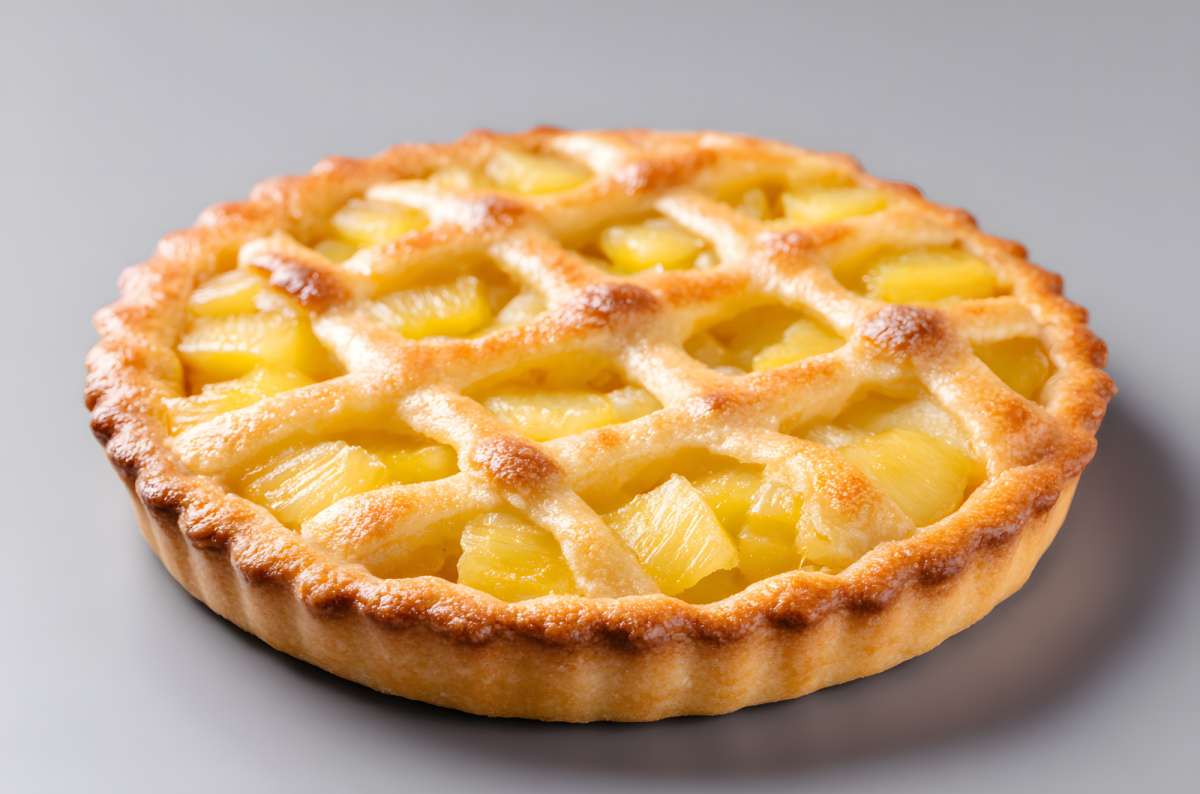
Tarte au riz—a creamy rice pie that’s a classic Belgian Christmas treat. Save room for dessert!
For dessert, it’s often:
- Bûche de Noël (Yule log cake)
- Speculoos cookies or chocolate pralines
- And of course, crème brûlée or tarte au riz if you’ve got room left.
What do Belgians eat during Easter?
During Easter, Belgians swap bunnies for… well, chocolate bunnies. You’ll see them in every chocolate shop windows, and some of these creations are real masterpieces.
And for Saint Nicholas Day on December 6, kids get speculoos cookies, marzipan, and chocolate figurines — because in Belgium, sugar season basically starts a month before Christmas.
FAQs about Belgian food

Full after all that Belgian food? Walk it off at Mini-Europe in Brussels—tiny landmarks, big fun
What is the most traditional food in Belgium?
Moules-frites (mussels with fries) and Flemish beef stew are considered the most traditional Belgian dishes.
What food is Belgium famous for?
Fries, waffles, beer, chocolate, and hearty dishes like stoofvlees and meatballs.
What is a typical Belgian meal?
Usually meat or fish with fries and vegetables—and always with sauce.
What do Belgians eat for breakfast?
Bread with butter and jam, cheese, or speculoos spread, and coffee.
Do Belgians eat dessert?
Yes. A lot of it. Waffles, chocolate, rice tarts, and crème brûlée are all common.
What do vegetarians eat in Belgium?
Stoemp, cheese croquettes, and waffles—plus plenty of veggie options in cities like Ghent and Brussels.
Is Belgian food spicy?
No—Belgian cuisine focuses on rich, creamy, and savory flavors, not spice.
Is Belgian beer really that good?
Yes. And with over 1,500 kinds of beer, there’s no excuse not to find one you love.
You might also be interested in reading:
Sometimes, all you need to do is take the first step... I've filtered out the best hotels in Brussels for you
Save it for yourself to come back to later, or share with your friends on social media!
I've already planned your ititnerary for the trip, complete with my travel tips.
This post contains affiliate links. If you make a booking through one of my links, I may earn a small commission—at no additional cost to you. Thank you for your support!
What is the most traditional food in Belgium?
What food is Belgium famous for?
What is a typical Belgian meal?
What do Belgians eat for breakfast?
1. Belgian fries (not French fries!)
3. Belgian chocolate and pralines
6. Meatballs with tomato (or a different sauce)
Good to know: more traditional Belgian dishes
Belgian drinks and traditional beverages
Other traditional Belgian drinks
2. Jenever: Belgium’s answer to gin
3. Coffee: Belgians drink a lot of it
4. Hot chocolate: comfort in a cup
What do vegetarians eat in Belgium?
Typical Belgian meals—breakfast, lunch, and dinner





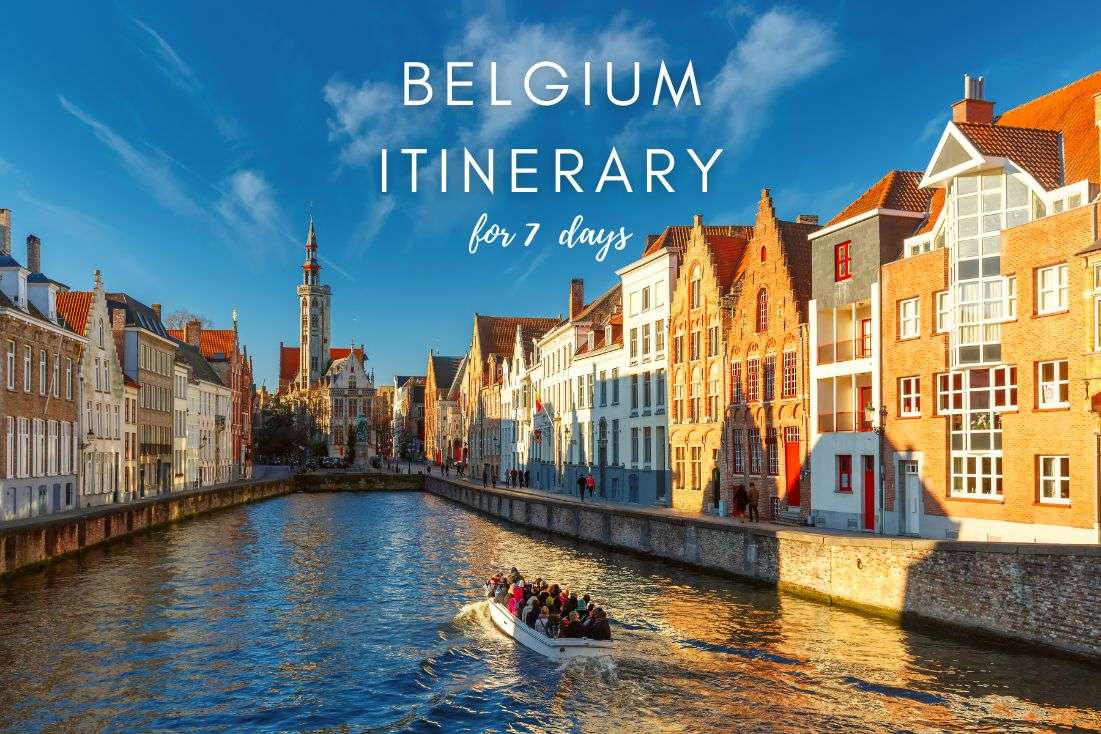
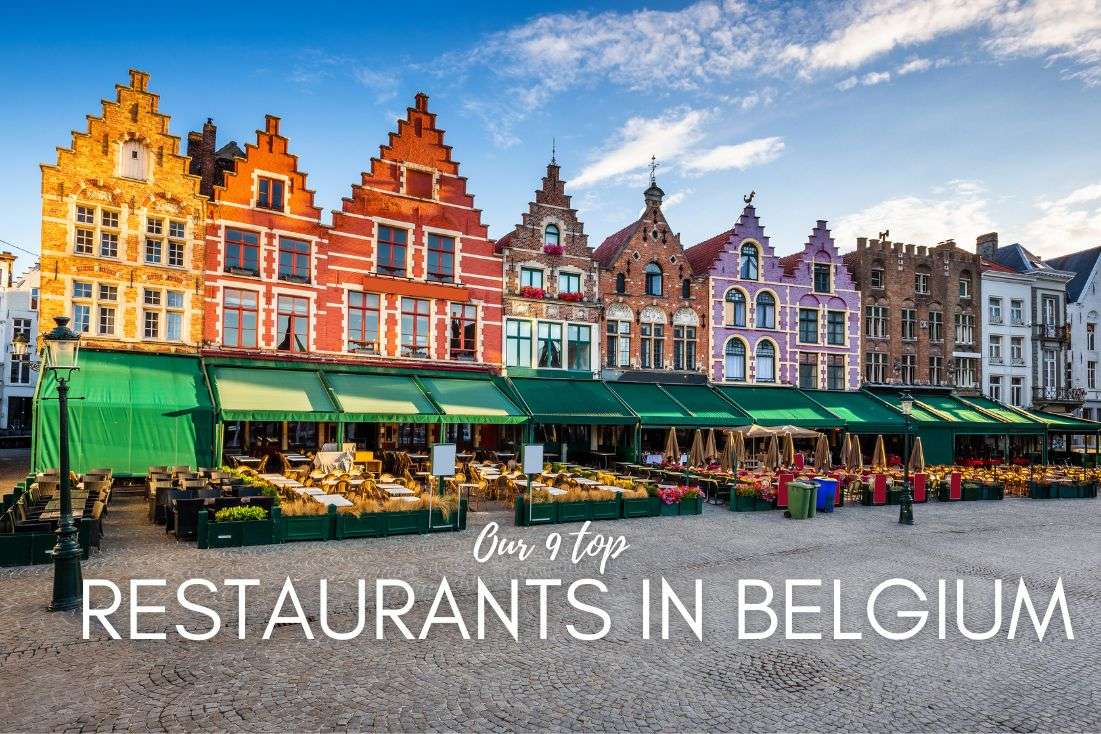



Comments | Thoughts? Give us a shout!